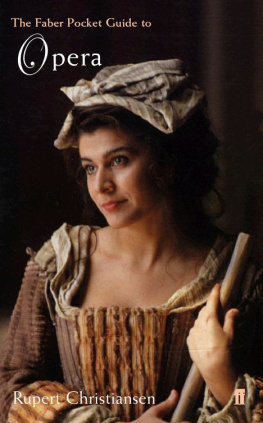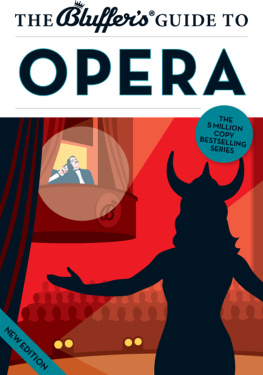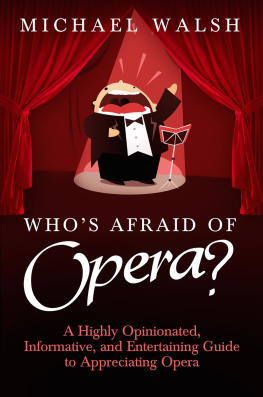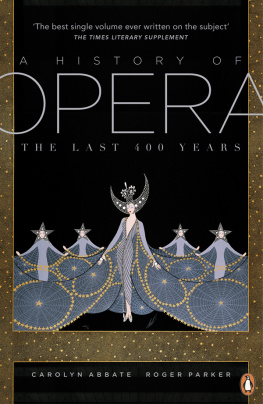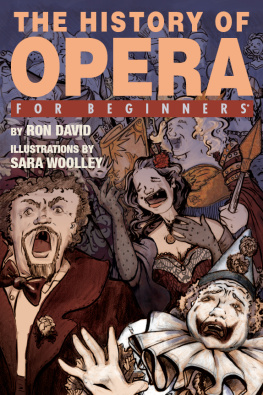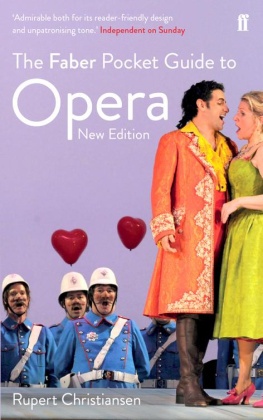Rupert Christiansen - Faber Pocket Guide to Opera
Here you can read online Rupert Christiansen - Faber Pocket Guide to Opera full text of the book (entire story) in english for free. Download pdf and epub, get meaning, cover and reviews about this ebook. year: 2004, publisher: Faber & Faber, genre: Non-fiction. Description of the work, (preface) as well as reviews are available. Best literature library LitArk.com created for fans of good reading and offers a wide selection of genres:
Romance novel
Science fiction
Adventure
Detective
Science
History
Home and family
Prose
Art
Politics
Computer
Non-fiction
Religion
Business
Children
Humor
Choose a favorite category and find really read worthwhile books. Enjoy immersion in the world of imagination, feel the emotions of the characters or learn something new for yourself, make an fascinating discovery.
- Book:Faber Pocket Guide to Opera
- Author:
- Publisher:Faber & Faber
- Genre:
- Year:2004
- Rating:3 / 5
- Favourites:Add to favourites
- Your mark:
- 60
- 1
- 2
- 3
- 4
- 5
Faber Pocket Guide to Opera: summary, description and annotation
We offer to read an annotation, description, summary or preface (depends on what the author of the book "Faber Pocket Guide to Opera" wrote himself). If you haven't found the necessary information about the book — write in the comments, we will try to find it.
Faber Pocket Guide to Opera — read online for free the complete book (whole text) full work
Below is the text of the book, divided by pages. System saving the place of the last page read, allows you to conveniently read the book "Faber Pocket Guide to Opera" online for free, without having to search again every time where you left off. Put a bookmark, and you can go to the page where you finished reading at any time.
Font size:
Interval:
Bookmark:
Rupert Christiansen was born in London and educated at Kings College, Cambridge. After further study as a Fulbright scholar at Columbia University, he has written several books including Prima Donna, Romantic Affinities, Paris Babylon, The Visitors and Arthur Hugh Clough. In 1997, he was elected a Fellow of the Royal Society of Literature. He is currently opera critic of the Daily Telegraph and a member of the editorial board of Opera magazine. He has contributed to many newspapers and magazines, including The Spectator, Times Literary Supplement, Harpers & Queen, Los Angeles Times, Vanity Fair and the New Yorker.
(15671643)
Orfeo (LOrfeo)
Prologue and five acts. First performed Mantua, 1607.
Libretto by Alessandro Striggio
It should be most unusual as all the actors are to sing their parts. Thus wrote Francesco Gonzaga, son of the Duke of Mantua, to his brother Ferdinando on the subject of an entertainment which he had asked the court composer Monteverdi to prepare for the carnival of 1607. Opera was still an experimental novelty at this point, although Monteverdi plainly knew of another musical staging of the Orpheus legend, performed in Florence five years previously.
The Mantuan performance took place in the private apartments of the dukes sister. There would have been little or no scenery, and there is evidence that the opera was played without an interval. The cast consisted of singers permanently employed by the court, with four of the female roles taken by castrati only the Orfeo, also a castrato, was borrowed from the Grand Duke of Tuscany. Copies of the libretto were handed to the small private audience of courtiers, and the performance was so successful (women wept because nothing like this had been heard before, reported the court chronicle) that it was repeated a few days later.
 Plot
PlotOrfeo (Orpheus), the renowned Thracian singer, rejoices in his love for his wife Euridice. When a messenger brings news that she has died of a snake bite, he is so grief-stricken that he resolves to venture into Hades and plead with Pluto to restore her to life. Using all his musical powers, he lulls Charon, who ferries the dead across the river Styx, to sleep and makes his way into Plutos domain. When he presents his case, Plutos wife Proserpina is so moved that she persuades her husband to break the immutable law of death and restore Euridice to life. Out of love for Proserpina, Pluto agrees, on condition that Orfeo does not turn to look at Euridice on the journey back. But Orfeo, always ruled by emotion rather than reason, cannot resist the temptation, and Euridice is lost to him again. Disconsolate, he returns to Thrace. The god Apollo intervenes, and turns both Orfeo and Euridice into stars in the night sky.
 What to listen for
What to listen forAs in early Greek tragedy, the chorus plays the dominant role, framing the soloists monologues and dialogues with a series of madrigals and dances.
Two episodes exemplify aspects of Monteverdis dramatic genius. The Messenger (mezzo-soprano) who brings Orfeo news of Euridices death recounts the incident in extraordinarily varied music which vividly evokes the scene and the emotions which the tragedy provokes. The plea that Orfeo (tenor) makes to Charon, Possente spirto, doesnt have a story to tell, but is charged with a high pitch of intensity, and decorated with the vocal ornaments and flourishes that mark this phase of baroque music one of the most obvious being the goat trill, in which the same note is repeatedly hammered at the end of a phrase.
For singers, the major challenge presented by Monteverdi is that of drawing out the emotional nuances while keeping the line classically clean and clear. In Tosca or MadamaButterfly, an effect can be made by sobbing, rasping, shrieking or holding a note longer than the score indicates, but such tricks dont work in an opera like Orfeo. Monteverdis operas require lighter, sweeter, more flexible voices than those of Puccini, and although they make no great demands in terms of physical range or volume, they provide an acid test of the capacity to sustain a vocal line through smooth breath control.
Although musicologists disagree about the precise balance of instruments and the details of what and how they should play, the operas orchestration can broadly speaking be said to consist of keyboards (chamber organ or harpsichord) and both bowed (violins, violas and cellos) and plucked (lutes and harp) strings, with recorders and brass instruments such as cornets and sackbutts being added for dances, fanfares and processions. On first hearing, the carpet of sound can seem rather threadbare and monochrome, but familiarity will reveal the richness of the palette. Every syllable of the text should be immediately audible.
 In performance
In performanceThis opera appears to have been occasionally performed in Italy until the mid-seventeenth century, but its first full-scale modern revival took place in Paris in 1911. Since then, the sketchy indications of instrumentation and harmonization in the score published in 1609 have allowed free play of interpretation . Broadly speaking, the fashion for modern composers (Orff, Hindemith, Dallapiccola, Berio and Henze among them) fleshing Monteverdis bare bones out with music composed in their own idioms has passed, and the trend now is for scholar-conductors (Nikolaus Harnoncourt, Roger Norrington and John Eliot Gardiner among them) to aim at the maximum degree of historical authenticity, using reconstructions of baroque instruments and following original performance practice though the surviving evidence for this is often so ambiguous and scanty that what constitutes this authenticity remains hotly contested and conjectural.
Most productions aim to recreate either the splendours of seventeenth-century baroque or the simplicity of Ancient Greece, but the most successful recent staging is probably that of David Freeman at ENO, which presents the opera as if it was being enacted by a community of Balkan peasants. They appear to devise the performance before the audiences eyes, dancing as well as singing, with the soloists also part of the chorus. The action gains in spontaneity and emotional immediacy whatever it loses in authentic courtly formality.
 Recording
RecordingCD: John Mark Ainsley (Orfeo); Philip Pickett (cond.). LOiseau Lyre 433 545 2
(TheReturnofUlyssestohisHomeland)
Prologue and three acts. First performed Venice, 1640.
Libretto by Giacomo Badoaro
Unlike the courtly and dignified Orfeo, this is an opera composed for a sophisticated public of merchants and entrepreneurs . By the late 1630s, opera had become a popular form of commercial entertainment in the wealthy republic of Venice, and its paying audiences demanded something other than the ethical seriousness of the earliest operas hence the introduction of elements of spectacle and knockabout humour.
The plot is drawn from books 13 to 23 of Homers Odyssey. The score survives in one anonymous manuscript, discovered in Vienna, and only informed guesswork ascribes it to Monteverdi.

Font size:
Interval:
Bookmark:
Similar books «Faber Pocket Guide to Opera»
Look at similar books to Faber Pocket Guide to Opera. We have selected literature similar in name and meaning in the hope of providing readers with more options to find new, interesting, not yet read works.
Discussion, reviews of the book Faber Pocket Guide to Opera and just readers' own opinions. Leave your comments, write what you think about the work, its meaning or the main characters. Specify what exactly you liked and what you didn't like, and why you think so.

